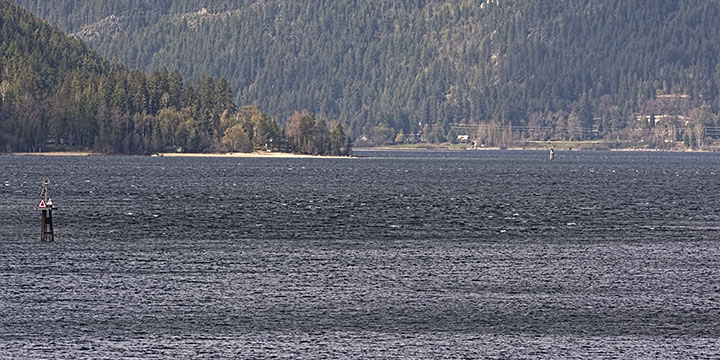A rip is stretch of fast-flowing and rough water.
Much confusion arises from that simple definition:
- In the public’s mind, the only rip is the particular one that is often called a rip current, but, given its provenance, really should really be called a beach rip. A beach rip is the strong narrow current that moves offshore as a concentrated flow. It is generated by the return flow of waves breaking on a beach. While on ocean shores, it is viewed as a danger to swimmers, it isn’t of much concern on our lake.
- Then there is something called a rip tide which is an oceanographic term for a strong tidal flow through a constriction. There are no tides on our lake. (There is some confusion evinced by websites that assume that a rip tide is a misnomer for a rip current—it isn’t.)
While neither of these would seem to have much applicability to Kootenay Lake, we do have rips, and they behave in a similar manner to the oceanographer’s rip tide.
The residency time for water on the West Arm of Kootenay Lake is three to four days, which means that this is the average time it takes water to travel westward along the arm from Balfour to Nelson. This corresponds to an average westerly drift of a stately third of a kilometre an hour. A feature of this arm is that it is occasionally constricted by creek deltas to produce what are known as the narrows. Through these, the flow is more like that of a river than a lake. So, while not being driven by a tide, the flow can reach the magnitude of the oceanographer’s rip tide.
However, a rip involves more than a fast current: it requires the water to be rough. For that we need the interesting aspect of wave behaviour that occurs when waves move in the opposite direction of the current.
Start with a brisk westerly wind in one of the lakelets between the narrows. The wind causes waves to propagate against the easterly current, but in the broad lakelet, the current is light and this is of little account. However, if the current moving against the waves is greater than the speed at which the waves are moving, the waves are brought to a stop. Consequently, waves may not be able to enter the narrows with its faster current.
What is particularly interesting is what happens as the waves move towards the progressively faster counter current in the narrows. As waves approach the narrows and the current increases, the wavelength shortens and the wave amplitude increases: the waters become quite rough.
When there is a west wind, the western entrance of the narrows has not only a strong current but really rough water. This is the rip. However, within the narrows where the waves generated in the lakelet haven’t been able to penetrate, it is much calmer and the current is strong.
Here is a view looking west though the Nine-mile Narrows. The nine-mile dolphin is on the left and the distant seven-mile dolphin is on the right. There is a west wind (out of picture) that is building waves in the lakelet between them. But, as the waves approach the narrows, the water becomes quite rough: this is the rip. Closer, at the bottom of the picture, the water in the narrows is much calmer. (The darker water near the bottom of the picture is a cat’s paw print.)

Very interesting. I was just reading about rip tides and currents. The author said that rip tide was a misnomer and it should be called a rip current. Thanks for clarifying that for me, I wondered…